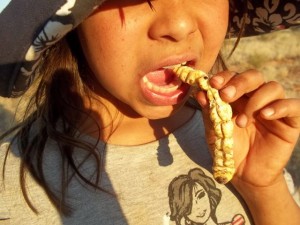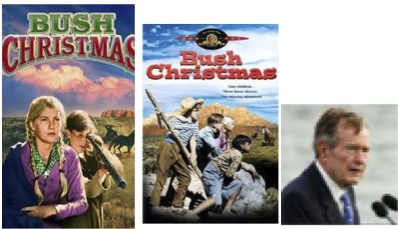Film Review A Bush Christmas, 1947, with Dave Strappon and Margo Promenhance
The opening scene of this Australian film presents us with a vignette of kids leaving school in the bush on ‘breakup-day’. One of the conventions of this “bush genre’ school of cinema is that it presents a romanticised view of ‘country’ that was designed to encourage as many British citizens as possible to emigrate in pursuit of a life that Britain was no longer able to provide. Though over fifty percent of Australians lived in cities this film presents the mythological lie that we’re all knockabout bushman, capable of riding, shooting, and surviving in the bush.
In the story the holidaying kids decide to take a short cut over “blacks’ country”. Its an innovative post war acknowledgement to include Neeza who is actually aboriginal. He rides pillion on the back of Johns horse. They encounter two rogues, busy changing the markings of some local horses. Chips Rafferty plays the senior rogue – the archetypal mid-century Australian, lean, muscular and laconic, (a William Dobell inspired study in wiriness). These rogues chat to the kids who are guileless and unsuspecting, and offer them a shilling each if they don’t tell the grown ups what they‘ve seen on the hill. The kids subsequently discover they’ve been duped, and determine to retrieve the stolen horses.
The rogues – now thieves- display a deal of incompetence as bit by bit they are deprived of boots, food, and horses on their flight to an abandoned town. There they catch and tie up their young pursuers. Then the rescue with a brief shootout as the police arrest the thieves, and congratulate the kids on their courage and daring.
Final scene christmas dinner on the verandah, high summer and laughter, stern but adoring parents, and classic orchestral refrain.
It would be impossible to make a film like this now. The children ride helmet-less, and when they fall, don’t require counseling, stress management or intercession on behalf of child protection agencies. This is a radical take on childhood. Each kid has a distinctive personality, and not everybody gets a prize. The aboriginal kid, though the butt of ‘good natured’ colour jokes, is skilled, ingenious, good humoured, and an acknowledged Leader. The other Leader is the older girl, it is she who decides to pursue the thieves across range and country, and details the party which raids their camp.  The kids live off the land, they know how to track, light fires, and entertain themselves and be independent. Even the littlest can ride competently and (when forced) will eat Witchetty Grubs as demonstrated by the plucky Neeza.
The kids live off the land, they know how to track, light fires, and entertain themselves and be independent. Even the littlest can ride competently and (when forced) will eat Witchetty Grubs as demonstrated by the plucky Neeza.
As in Smiley* this exploration, adventure, and engagement with the world around them is shared with a backdrop of fire-crackers, brawls, bushfires and baddies. All good humouredly acknowledged by the police sergeant who knows the townsfolk, and exerts authority through his respect for and familiarity with the people. We all know this is not true either, as society was cold, insular, neglectful and sub-Dickensian. The nostalgia is knowing that nothing’s changed.
This really is a radical film that deserves another look.
* Smiley Gets a Gun 1958. I believe the genre endured till TV’s ‘Skippy’, then the bush as ‘evil and dangerous’ returned; mysterious, untamable – cf. Picnic at Hanging Rock. , Hence contemporary bushfire neurosis and delusions of certainty and suburbia.


Pingback: Weekly Wrap 5 August 2013 | pcbycp